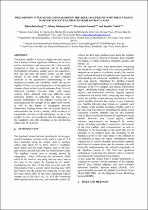 ResearchSpace
ResearchSpace
Preliminary inter-model comparison of the Agulhas current with direct range doppler velocity estimates from Envisat's Advanced Synthetic Aperture Radar (ASAR)
JavaScript is disabled for your browser. Some features of this site may not work without it.
- ResearchSpace
- →
- Research Publications/Outputs
- →
- Conference Publications
- →
- View Item
| dc.contributor.author |
Backeberg, Bjorn-Christoph

|
|
| dc.contributor.author |
Johannessen, J

|
|
| dc.contributor.author |
Rouault, Marjolaine J

|
|
| dc.contributor.author |
Veitch, J

|
|
| dc.date.accessioned | 2011-09-05T13:18:07Z | |
| dc.date.available | 2011-09-05T13:18:07Z | |
| dc.date.issued | 2010-07 | |
| dc.identifier.citation | Backeberg, B-C., Johannessen, J., Rouault, M., et al. 2010. Preliminary inter-model comparison of the Agulhas current with direct range doppler velocity estimates from Envisat's Advanced Synthetic Aperture Radar (ASAR). ESA Publication division. Bergen, July 2010, pp. 7PP | en_US |
| dc.identifier.uri | http://hdl.handle.net/10204/5145 | |
| dc.description | ESA Publication division. Bergen, July 2010 | en_US |
| dc.description.abstract | The greater Agulhas Current is a highly dynamic regime that is known to have significant influence on the local marine environment and ecosystem. It is also recently recognized to play an important role in the global thermohaline circulation, notably due to the transport of heat and salt from the Indian Ocean via the South Atlantic to the North Atlantic. In these contexts, advances in the quantitative understanding of the dominant processes and variability within the greater Agulhas Current is of great importance. In this paper we compare direct surface velocity estimates from Envisat's Advanced Synthetic Aperture Radar with surface velocity fields obtained from two different ocean numerical models. In particular, we focus on the models' performance in the Agulhas Current core at simulating both the strength of the upper layer current as well as the degree of topographic steering. Preliminary findings reveal that the models distinctly underestimate the surface current, while evidence of topographic steering is only satisfactory in one of the models. In turn, we hypothesize that the simulation of the variability and eddy shedding in the retroflection region may be incorrect. | en_US |
| dc.language.iso | en | en_US |
| dc.relation.ispartofseries | Workflow;7043 | |
| dc.subject | Agulhas current | en_US |
| dc.subject | Advanced Synthetic Aperture Radar (ASAR) | en_US |
| dc.subject | Topographic steering | en_US |
| dc.subject | Surface velocity | en_US |
| dc.title | Preliminary inter-model comparison of the Agulhas current with direct range doppler velocity estimates from Envisat's Advanced Synthetic Aperture Radar (ASAR) | en_US |
| dc.type | Conference Presentation | en_US |
| dc.identifier.apacitation | Backeberg, B., Johannessen, J., Rouault, M. J., & Veitch, J. (2010). Preliminary inter-model comparison of the Agulhas current with direct range doppler velocity estimates from Envisat's Advanced Synthetic Aperture Radar (ASAR). http://hdl.handle.net/10204/5145 | en_ZA |
| dc.identifier.chicagocitation | Backeberg, Bjorn-Christoph, J Johannessen, Marjolaine J Rouault, and J Veitch. "Preliminary inter-model comparison of the Agulhas current with direct range doppler velocity estimates from Envisat's Advanced Synthetic Aperture Radar (ASAR)." (2010): http://hdl.handle.net/10204/5145 | en_ZA |
| dc.identifier.vancouvercitation | Backeberg B, Johannessen J, Rouault MJ, Veitch J, Preliminary inter-model comparison of the Agulhas current with direct range doppler velocity estimates from Envisat's Advanced Synthetic Aperture Radar (ASAR); 2010. http://hdl.handle.net/10204/5145 . | en_ZA |
| dc.identifier.ris | TY - Conference Presentation AU - Backeberg, Bjorn-Christoph AU - Johannessen, J AU - Rouault, Marjolaine J AU - Veitch, J AB - The greater Agulhas Current is a highly dynamic regime that is known to have significant influence on the local marine environment and ecosystem. It is also recently recognized to play an important role in the global thermohaline circulation, notably due to the transport of heat and salt from the Indian Ocean via the South Atlantic to the North Atlantic. In these contexts, advances in the quantitative understanding of the dominant processes and variability within the greater Agulhas Current is of great importance. In this paper we compare direct surface velocity estimates from Envisat's Advanced Synthetic Aperture Radar with surface velocity fields obtained from two different ocean numerical models. In particular, we focus on the models' performance in the Agulhas Current core at simulating both the strength of the upper layer current as well as the degree of topographic steering. Preliminary findings reveal that the models distinctly underestimate the surface current, while evidence of topographic steering is only satisfactory in one of the models. In turn, we hypothesize that the simulation of the variability and eddy shedding in the retroflection region may be incorrect. DA - 2010-07 DB - ResearchSpace DP - CSIR KW - Agulhas current KW - Advanced Synthetic Aperture Radar (ASAR) KW - Topographic steering KW - Surface velocity LK - https://researchspace.csir.co.za PY - 2010 T1 - Preliminary inter-model comparison of the Agulhas current with direct range doppler velocity estimates from Envisat's Advanced Synthetic Aperture Radar (ASAR) TI - Preliminary inter-model comparison of the Agulhas current with direct range doppler velocity estimates from Envisat's Advanced Synthetic Aperture Radar (ASAR) UR - http://hdl.handle.net/10204/5145 ER - | en_ZA |





